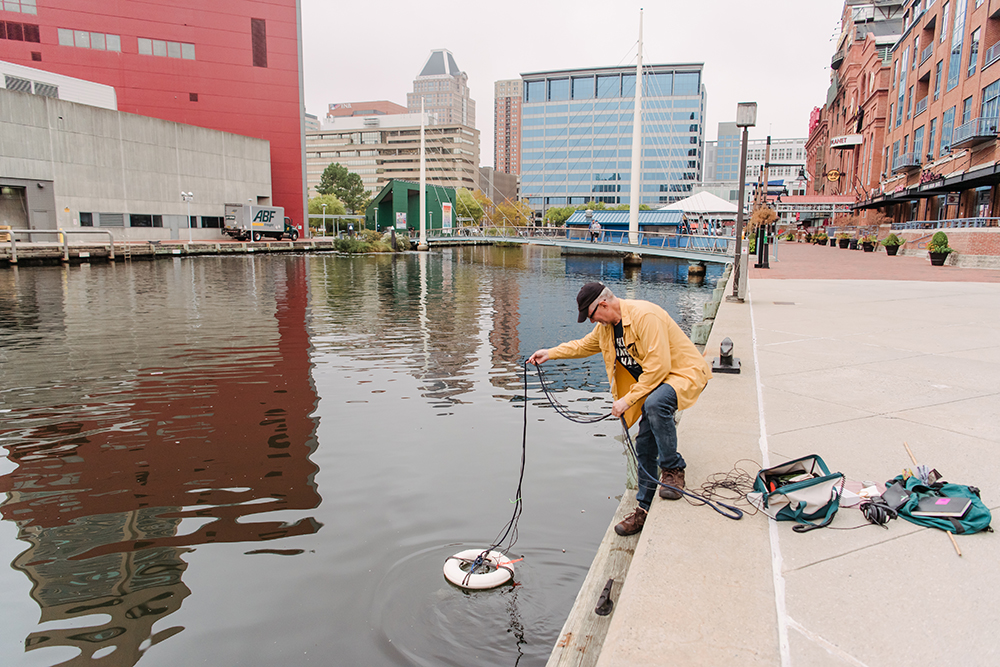IMET Artist-In-Residence featured in UMBC Magazine
December 14, 2021
 Stephen Bradley, an associate professor in the Department of Visual Arts at UMBC, was IMET’s third artist-in-residence. IMET’s artist-in residence program collaborates with UMBC’s Center for Innovation, Research, and Creativity in the Arts (CIRCA). Each year one professor within UMBC’s college of arts is selected to work and collaborate with IMET faculty on a project of their own design.
The big picture goal of Stephen’s project is to increase the connection that urban residents feel for the living resources in nearby estuaries that they both enjoy and affect. We seek to accomplish this by inviting them to observe and listen to the small, sessile organisms in the estuary (harbor) with the aid of a mobile microscope, video screen, and hydrophone (underwater listening device) that is housed in an aesthetically attractive buggy that has the same kind of appeal as an ice cream cart. We have identified a three-part need, to support (1) the final stages of the fabrication of the Bio Buggy, a mobile art and science lab on wheels that will be instrumental for collecting field ecological information; 2) the ecological data collection/documentation process and (3) the use of resulting biodiversity observations in art and science engagement methodologies that will be co-developed with community and NGO partners. The primary focus would be on the Brooklyn and Curtis Bay neighborhoods located in South Baltimore City.
The knowledge gained will inform current land use, greening efforts, water remediation and enhancing the multifunctionality of the green infrastructure currently underway at Garrett Park, Brooklyn. However, many members of the community share friendships, family, work and leisure circles in the adjoining zip codes.
The mobile biodiversity lab, aka Bio-Buggy, will enable the team to transport research equipment safely to different research and public engagement sites. Creating sound-art compositions expands the biodiversity study by including the analysis of noise and documenting the effects of solid waste on local habitats that are part of the study.
Stephen Bradley, an associate professor in the Department of Visual Arts at UMBC, was IMET’s third artist-in-residence. IMET’s artist-in residence program collaborates with UMBC’s Center for Innovation, Research, and Creativity in the Arts (CIRCA). Each year one professor within UMBC’s college of arts is selected to work and collaborate with IMET faculty on a project of their own design.
The big picture goal of Stephen’s project is to increase the connection that urban residents feel for the living resources in nearby estuaries that they both enjoy and affect. We seek to accomplish this by inviting them to observe and listen to the small, sessile organisms in the estuary (harbor) with the aid of a mobile microscope, video screen, and hydrophone (underwater listening device) that is housed in an aesthetically attractive buggy that has the same kind of appeal as an ice cream cart. We have identified a three-part need, to support (1) the final stages of the fabrication of the Bio Buggy, a mobile art and science lab on wheels that will be instrumental for collecting field ecological information; 2) the ecological data collection/documentation process and (3) the use of resulting biodiversity observations in art and science engagement methodologies that will be co-developed with community and NGO partners. The primary focus would be on the Brooklyn and Curtis Bay neighborhoods located in South Baltimore City.
The knowledge gained will inform current land use, greening efforts, water remediation and enhancing the multifunctionality of the green infrastructure currently underway at Garrett Park, Brooklyn. However, many members of the community share friendships, family, work and leisure circles in the adjoining zip codes.
The mobile biodiversity lab, aka Bio-Buggy, will enable the team to transport research equipment safely to different research and public engagement sites. Creating sound-art compositions expands the biodiversity study by including the analysis of noise and documenting the effects of solid waste on local habitats that are part of the study.